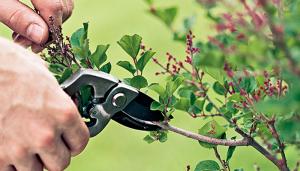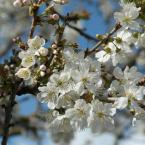WHY PRUNE TREES AND SHRUBS?
Plant health is the primary reason for pruning. Look for the 4 “Ds”—dead, dying, diseased, or damaged branches—these should be removed. Also look for spindly or weak growth, as well as any branches that are crossed or rubbing.
WHEN TO PRUNE TREES AND SHRUBS
When to prune trees and shrubs is a hot topic, and it’s no question that spring is the ideal time to inspect your trees and shrubs for winter damage. It is much easier to see the structure of deciduous plants without their leaves, so pruning can be accomplished quickly and easily. Most trees are still in a state of dormancy and will bleed less sap, and insects and diseases are less active.
The basic rule of thumb is to prune spring-flowering shrubs right after they bloom in order to avoid cutting off next year’s buds. Shrubs such as forsythia, lilac, star magnolia, mock orange, azalea, rhododendron, mountain laurel, dogwood, sand cherry, quince, and andromeda develop their buds on old wood—branches that grew last year. If you wait until after they bloom, you can deadhead and prune at the same time. This will encourage lots of new growth and give you more flowers next year.
Shrubs that blossom late in the summer, such as Hydrangea paniculata, rose of Sharon, clethra, and buddleja set their buds on new wood. They often bloom best if they have been cut back while dormant in late winter to encourage more new wood to form. When thinning deciduous shrubs, remove the oldest, tallest growth first and then take out weak or spindly stems. For renewal pruning on multi-stemmed shrubs, such as forsythia, lilacs, or viburnum, take out 1/3 of the oldest stems each year to encourage new growth.
The art of pruning is a skill that you can develop over time. Don’t be afraid to experiment and learn as you go, and don’t hesitate to consult a good book on the subject or check with your county extension office for information on pruning specific plants. By knowing your plant, its purpose, and especially when it blooms, you will be able to prune it correctly. If you would like to have a free consultation from Green Top Lawn and Landscape please feel free to call us at 302-856-6690 or visit us online greentoplawns.com






















































